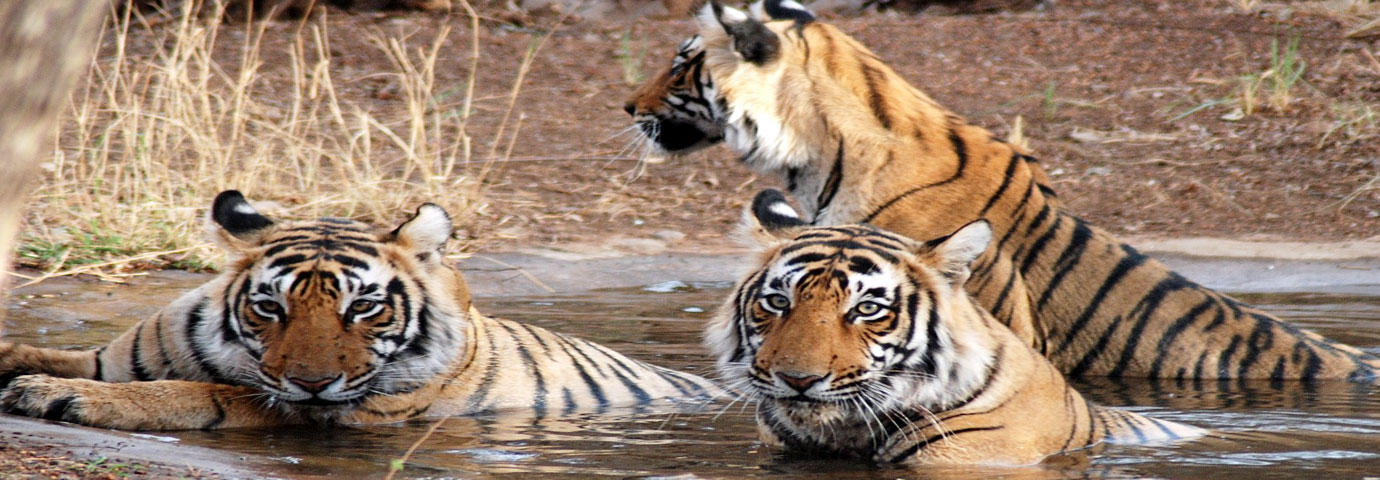Fast Facts
|
Area
|
614 sq km
|
|
Altitude
|
152 - 183 meters level
|
|
Languages
|
Hindi and English
|
|
Best Time to Visit
|
Mid November to Mid June
|
The Dudhwa Tiger Reserve in the Lakhimpur-Kheri district of Uttar Pradesh is one of the finest examples of the exceedingly diverse and productive Terai eco-systems. The reserve has an area of 614 sq km. The northern edge of the reserve lies along the Indo-Nepal border while the southern boundary is marked by the river Suheli. It is home to a large number of rare and endangered species, which include tiger, leopard, swamp deer, hispid hare, Bengal floricans, etc.
Best Time To Visit
Like the rest of north India, Dudhwa also has an extreme type of climate. Summers are hot with the temperature rising up to 40°C. During winters, the temperature hovers between 20°C and 30°C. The average annual rainfall is 1,600 mm.
Tourists Attractions
The grasslands of the reserve are the habitat of the largest kind of Indian deer-the swamp deer or the Barasingha, called thus because of their magnificent antlers (bara-twelve; singha-antler). Decline in their habitats led to a drastic decline in numbers and a small area named Sonaripur Sanctuary was set aside in 1958 for the conservation of this rare species of deer. Later, it was upgraded to cover an area of 212 sq km and was renamed the Dudhwa Sanctuary. In 1977, the area was further extended to include over 614 sq km and was declared a national park. Eleven years later, in 1988, when Dudhwa became a part of Project Tiger, the area of the Kishanpur Sanctuary was added to create the Dudhwa Tiger Reserve. About 1,800 Barasingha live in the reserve now and their majestic herds are often seen, especially in the grassy wetlands of the Sathania and Kakraha blocks.
Apart from the swamp deer, there are at least 37 species of mammals, 16 species of reptiles and 400 species of avifauna. Dudhwa is said to have 101 tigers and four leopards. Recently, the hispid hare has also been sighted from this area.
It was here in 1984 that a major rhinoceros rehabilitation project was started since these forests had been the habitat of the rhinoceros 150 years ago. Five rhinos were relocated from Assam but two of the females died due to the strains of transportation. These were replaced in 1985 by four more females from Nepal.
The Terai area in the sub Himalayan belt, which holds an extremely dynamic habitat for a wide range of animal communities, has some uniqueness and serves the humanity in the plains, down south, in many ways.
The major vegetation types in this region are tropical semi-evergreen forest, tropical moist deciduous forest, riparian and swamp forest and dry deciduous forest. The dominant tree species are Shorea robusta, Terminalis tomentosa, Adina cordifolia, Terminalia belerica, Eugenia jambolana, Dalbergia sissoo, and Bombax malabaricum. The various types of forests throughout the park are interrupted by wide stretches of mesophyllous grasslands locally called the phantas.
Places Around Dudhwa
En route to Dudhwa, the unique Frog Temple at Oyal can also be visited. The only one of its kind in India, it was built by the former Maharajas of the Oyal state in the district of Lakhimpur-Kheri. Dedicated to Lord Shiva, the base of the stone temple is built in the shape of a large frog. The temple is at a distance of 10 km from Hargaon on the route to Lakhimpur-Kheri and Dudhwa.
Built in the Indo-Saracenic style by the rulers of the Singhai state, Surat Bhawan Palace is one of the famous palaces of the Terai area. Not far from the Dudhwa Tiger Reserve on the Lakhimpur-Nighasan-Dudhwa route, the palace is set in a large green, nine-acre retreat. Expanses of lush lawns, fountains, a swimming pool and interesting architectural details make a visit to the palace worthwhile.
How To Reach
By Air - The nearest airport is Lucknow, connected to many places in India including Delhi and Mumbai by regular flights.
By Rail - The nearest railway stations are Dudhwa 4 km, Palia 10 km, and Mailani 37 km. Dudhwa, on North-Eastern Railway meter gauge section is connected via Mailani to Lucknow & Nainital.
By Road - Upsrtcand private bus services link Palia to Lakhimpur Kheri, Shahjahanpur, Bareilly, and Delhi etc. Buses ply frequently between Palia and Dudhwa.
Important road distances are Lucknow - 238 km, Bareilly - 260 km, Delhi - 430 km, Palia - 5 km.


